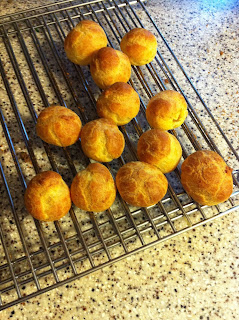The "simple" part: the ingredients. Flour, water, a little salt, a fat (we tried both lard and canola oil) and possibly a little baking powder. And, in fact, making the dough is simple - combine/cut the fat into the flour (and baking powder, if you're using it), add salted water a little at a time until you have a dough that you can form into a cohesive ball but is still fairly dry, rest it, form it, cook it.
Ah yes: form and cook. The "not easy" part. Actually, even the dough falls in the "not easy" category, because ratios and resting times and environments vary.
Recipes: we tried two approaches. Mad Kitchen Scientist and I worked variations on Diana Kennedy's very traditional approach. She recommends bread flour and vegetable shortening. We used The Only Flour You'll Ever Need (accept no substitutes) and lard. Hey, if you're going to go traditional, go traditional. Diana's recipe is a pound of flour, cut in 4 oz. of fat, then moisten with 1 tsp. of salt dissolved in 1 cup of warm water. Even on a dry, cold day, we didn't need a full cup of water - we needed a little more than 3/4 c. water to make a nice dough. And, in the first batch, we found that 4 oz. of lard was a bit too much - the tortillas turned out a little too flaky. They tasted great, but they reminded everyone of pie crust. In a second round, we went with 3 oz. of lard to greater success.
For the forming, we rolled the dough into 10 roughly equal sized balls and let them rest. Diana says rest the dough for anywhere from 20 minutes to 2 hours, but I'd recommend letting them rest at least an hour - we started forming tortillas at 20 minutes, and the dough was far more cooperative at the end. Diana recommends patting and stretching them into shape by hand. We also had two tortilla presses, which are vital to forming corn tortillas, and rolling pins. The tortilla presses couldn't get them thin enough. The "by hand" method might work if you've been forming tortillas since childhood, but it didn't work for us. The method that worked the best was rolling the tortillas out on a Silpat to about an 8 inch diameter.
Then on to the cooking: dry cast iron, either a griddle or a large skillet, over medium heat. The Executive Committee was manning the stove, and what she discovered is that the tortillas needed to cook 1-2 minutes per side depending on how thick they were, but that the key, contrary to the advice, is to flip several times, so you can keep an eye on browning progress.
Meanwhile, Chef Spouse took the Cooking for Geeks approach: find all the recipes you can, create a grid of ingredients and quantities, and use that to figure out what your ratios should be. His recipe included 2 cups of flour, 1 1/2 tsp. baking powder, 1 tsp. salt, 2 Tbsp. canola oil, and 3/4 c. water. Combine all, adding the water slowly, and mixing until you get to the point you need to start kneading. Still form the dough into about 10 equally sized balls and rest about 30 minutes, then roll out, being careful to avoid rolling over the edges (you don't want them to get thinner than the rest of the tortilla, or they'll be brittle), although his dough kept springing back on him, which made getting to an 8 inch diameter a little tough. Cook the same way as above. They were...biscuity. In the second batch, he took the baking powder down to 1 tsp. and rested the dough in the refrigerator before rolling out. Both were improvements - the dough was more cooperative with being rolled out and the flavor was better - but I still liked the lard-based dough better. Mad Kitchen Scientist agreed with me, but I think everyone else - Chef Spouse, the IAs, The Executive Committee - preferred the non-lard tortillas.
Unlike with corn tortillas, you don't want to store flour tortillas under a tea towel. While the steam created by the heat keeps the corn tortillas pliable, steam with flour-based dough just makes it get pasty spots. Yuck.
Papa IA, whose job, we've all decided, is to encourage us to push the envelope, came up with a plan for cocoa tortillas. We based it on Diana Kennedy's recipe, half batch: 7 oz. flour, 1 oz. unsweetened cocoa powder, a solid shake of cayenne, a solid shake of cinnamon, 2 oz. lard, and a little less than 1/2 c. of water with 1/2 tsp. salt dissolved in it. Combine the flour, cocoa, cayenne and cinnamon, cut in the lard, add the salt water slowly to form dough, shape into more like 6 balls, rest, roll out, cook. They were really good, and would be excellent as a wrapping for mole. Papa IA also discovered that sprinkling on a little powdered sugar and then dipping in a Mexican anise liquor he'd brought was delish as well.
On the tortillas, we ate Mad Kitchen Scientist's pork chili verde and Chef Spouse's flank steak fajitas. To drink? The Executive Committee brought the makings of sangria, and Chef Spouse and I had found the first blood oranges of the season, which we juiced for blood orange margaritas.
What did we learn? Simple but not easy, flour tortillas can be learned in an afternoon, but they'll take some time to master. With our Super Bowl party coming up in two weeks, we'll be eating a lot of Mexican food so Chef Spouse can keep practicing. Also, Chef Spouse needs a cast iron griddle.













